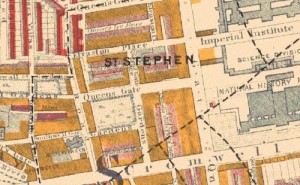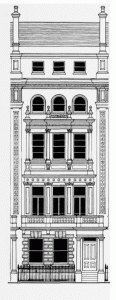Lancaster Gate, according to the Charles Booth, is mostly composed of people from upper middle and upper classes. The area has many mansions, such as “Bayswater House, an isolated mansion in the Bayswater Road, between Lancaster Gate and Orme Square.” Aside from having mansions, Kensington Gardens is located right across from Lancaster Gate (Nothing Hill and Bayswater).
Bayswater House was not the only mansion around the area. Since Lancaster Gate is across the street from Kensington Gardens, Kensington Palace is also located around the area. To get a better understanding of the wealth of the people, Queen Elizabeth was born here (The Victorian Web).
Due to the lavish lifestyles around the area, there are very few crimes reported according to the Old Bailey. One big crime that appeared was of Charles Lord Mohun, a man who died during a duel and was killed by John Hamilton.
In Romance of a Shop, Aunt Pratt lives in Lancaster Gate. Aunt Pratt is described as belonging “to that mischievous class of the community whose will and energy are very far ahead of their intellect and perceptions. She had a vulgar soul and a narrow mind, and unbounded confidence in her own judgments” (Levy Chapter 2). Aunt Pratt does not approve of the Lorimer’s sister photography shop. Aunt Pratt cares more about social appearances and looking like a proper woman, she even tells Gertrude “that now, of all times, you must be careful in your conduct; and among other things, you can none of you afford to be seen looking shabby” (Levy Chapter 3).
It is no surprise that out of all the sisters, Fanny, is the one who lives with her. Fanny, just like Pratt, is not very interested in running a photography studio. Her sisters assigned her the simplest job, a house keeper, due to her lack of interest. Both Fanny and Aunt Pratt are much more interested in living a lavish lifestyle and getting things easily, much like the people who lived in Lancaster Gate.
Work Cited
- Levy, Amy (2014-05-21). The Romance of a Shop (Black Heath Victorian Bookshelf) (Kindle Locations 400-403). Black Heath Editions. Kindle Edition.
- Walford, Edward. ‘Notting Hill and Bayswater.’ Old and New London: Volume 5. London: Cassell, Petter & Galpin, 1878. 177-188. British History Online. Web. 8 December 2015. http://www.british-history.ac.uk/old-new-london/vol5/pp177-188.
- “The Proceedings of the Old Bailey.” Browse. N.p., Mar. 2015. Web. 15 Dec. 2015.
- “Walking toward the Long Water. Kensington Gardens, London.” Walking toward the Long Water. Kensington Gardens, London. N.p., n.d. Web. 15 Dec. 2015.









